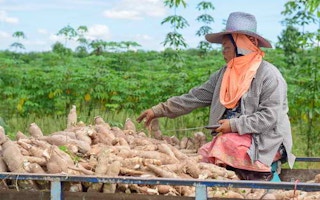Genomics, an emergent technology dealing with genes, is getting cassava scientists excited about the potential of growing more cassava in a much shorter time and much more efficient way.
Scientists believe this root crop — dubbed the “poor man’s fruit” — can be the solution to feeding the booming populations of developing nations. But finding investments to fund research and development for the plant has been difficult.
Feeding more than 500 million people worldwide, cassava is a carbohydrate source that is considered a staple crop and an important food security component in developing nations.
“Genomics can shorten breeding time to develop cassava varieties much quicker,” Wilhelm Gruissem, plant biotechnology professor at ETH Zurich, tells SciDev.Net.
Genomics uses sequencing to recognise specific genes in the genome, blazing the way for developing new environment-adapted, virus-resistant crop varieties with improved yields in a timely manner.
Gruissem says genomics is especially interesting for breeding new cassava varieties because the plant’s heterozygous parents, organisms with two different alleles of a gene, make the breeding process complex and challenging.
“Genomics technology allows us to breed cassava about three times faster than conventional breeding,” Claude Fauquet, director of the International Laboratory for Tropical Agricultural Biotechnology at The Scripps Research Institute and co-founder of the Global Cassava Partnership for the 21st Century, tells SciDev.Net.
While it typically takes 10-12 years to breed new varieties, with the help of genomics that time can be cut to 3-5 years, Fauquet explains.
“We need to invest further resources to obtain genome information, to better understand the construction of the genome and to understand what a good cassava variety is,” notes Gruissem. “We need to develop different high-yielding, virus-resistant cassava varieties that are adjusted to the preferences of farmers, consumers and industrial customers.”
But due to vegetative propagation — the plant is genetically identical to the parent and grows from parts of the parent plant — cassava has not been economically interesting to seed companies which cannot sell seeds of the plant. It has not found major interest either among developed nations which do not grow and consume the crop.
According to Fauquet, 75 per cent of cassava farmers grow cassava for their own consumption. But only 25 per cent of cassava production is utilised to generate food and non-food products such as starch, sweeteners and plastics.
Yet, the advantages of cassava over other crops are clear: it can sustain long droughts and grow in almost any type of soil. It is highly productive and semi-perennial, which gives it a flexible time window for harvesting.
The crop can be processed into hundreds of different food products and non-food products. The starch quality in cassavas is also much better than the starch quality in corn, says Gruissem.
“From my perspective, national governments have to understand the value and importance of this crop and invest in cassava research, breeding and technology,” he stresses.
Time is of the essence to breed more cassavas much faster. Hans Rosling, a professor at the Karolinska Institutet in Stockholm and the Royal Swedish Academy of Sciences, predicts that the population of Asia will grow 25 per cent while the African continent will see its population double to two billion people by 2050.

















